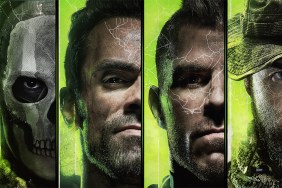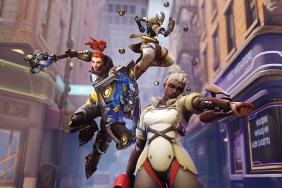Saving the world, one leap at a time.
Every super-ultra-secret police force has a set of special abilities. Some are bulletproof. Some can fly supersonic jets. Some are even experts at giving PSAs. The members of Pursuit Force specialize in vehicular leapfrog.
[image1]The central conceit of Pursuit Force: Extreme Justice is the ability to jump from speeding car to speeding car. (Idiots shouldn’t try this at home.) While this ability might not seem as useful as, say, an arsenal of sarcastic witticisms to stun criminals into senseless submission, flying from hood to hood at dangerous speeds is cool. Just like the prior game in the Pursuit Force series, playing automotive hop-scotch is a compelling gimmick.
What sets this game apart from its predecessor, however, are the improved mechanics and added variety in the styles of gameplay. There’s an array of vehicles scattered throughout the game on both land and sea, and each vehicle has its own unique feel and responsiveness. And while you won’t find much subtlety in terms of handling – the only real difference between vehicles is that bigger ones drive more slowly and are harder to steer – each vehicle has its strategic purpose.
In most of the thirty levels available in Story mode, you’ll speed along linear roadways and either chase down and kill a group of baddies, or protect another vehicle from an onslaught of freeway criminals. Other modes of play break up these sequences of vehicular manslaughter sequences. In some levels, you’ll man a turret mounted on the back of a moving car or on the side of a helicopter. In others, you’ll be sniping enemies from rooftop perches.
In addition, you’ll also need to step out of your car every so often and shoot people on foot, but apparently, the officers of Pursuit Force are much more coordinated while flying between car roofs than they are at walking around on their own two feet. Character movement is slow and cumbersome, and the too-forgiving auto-aim feature makes the on-foot sections ridiculously easy and all but pointless. On those few occasions in which enemies manage to get past your weapons fire, you’ll have to engage in a fist fight governed by a quick-time-event button press sequence. Not only are these brawling sections simple, but they also always lead to the same dull fight animations.
[image2]On-foot sequences are far better implemented in boss fights. You leap from one of your cars onto an overgrown beast of a vehicle and clamber around the huge hunk of metal, a la Shadow of the Colossus. Then, after a series of whack-a-mole-like shooting sequences where enemies peak their heads out of every hole and doorway imaginable, you’ll face off against a boss character. Each boss sequence requires little more than shooting at the boss and ducking his projectiles, but it’s cool climbing around the big mobile fortresses.
All in all, most of the non-vehicle sections are welcome, but I get the feeling that the developers are trying to compensate for a lack of depth by just adding more and more types of play. The game is at its best when it jumps wholeheartedly into its own shallowness and takes joy in its own cheesy one-liners and gameplay gimmicks.
The cheeseball storyline stands toe to toe with the best of the old-school Saturday morning lineup of superheroes and elite police squads. The game opens when a gang of wedding crashers literally crashes into the wedding of the unnamed “commander” of Pursuit Force. It’s like rain on your wedding day, only a lot less ironic. The good-spirited goofiness also appears in Pursuit Force’s “diverse” squad full of folks with bad foreign accents and ethnic stereotypes.
The enemy gangs also veer toward the side of poor taste. The Convicts are repeatedly identified as “southern hicks”. The Raiders are a rag-tag gang of swamp-loving creoles with dreadlocks and Caribbean accents. The chief of Pursuit Force loves calling the Syndicate “Limeys” so much that I didn’t realize the two were the same group until close to the game’s end. It goes without saying that the Warlords also come complete with their own bizarre “Russkie” appellation. But the game feels so much like an old Saturday morning cartoon that its quaint caricatures and borderline racism are utterly forgivable.
[image3]Once you beat Story mode, which is roughly a 6-8 hour feat, you will only have completed a small portion of the game’s generous offerings. Bounty mode lets you revisit each of the levels from Story mode and earn stars based on how well you do. Challenges mode lets you revisit very small portions of individual levels in an attempt to perform incredibly difficult tasks, some of which are sure to keep you busy for some time. There’s also a shop for purchasing unlockable content, including vehicles, characters, and cheats. Adding to the impressive list of extras is an ad-hoc multiplayer mode that lets you play locally in four different modes mixing cooperative and competitive play.
Pursuit Force: Extreme Justice is grounded by its single acrobatic gimmick. The game itself is a well-presented – but ultimately shallow – series of car chases, shooting sequences, and escort missions. The on-foot portions are in need of a fundamental redesign, but the other non-vehicle sections do a reasonably good job of mixing up the action. Pursuit Force isn’t the most promising title around, but when it comes to simple, straightforward thrills and action, it works. The lack of substance makes it the ideal game to be played in short sessions amidst any number of distractions. In fact, it’d be the perfect game to play while stuck in commuter traffic. What better place to fantasize about automotive agility?
-
Frogger on wheels
-
Lots of additional content
-
Good gameplay variety
-
Mindless fun
-
Stereotypical criminals, though forgivable
-
Awful on-foot sections
-
Please, no more quick-time events!










